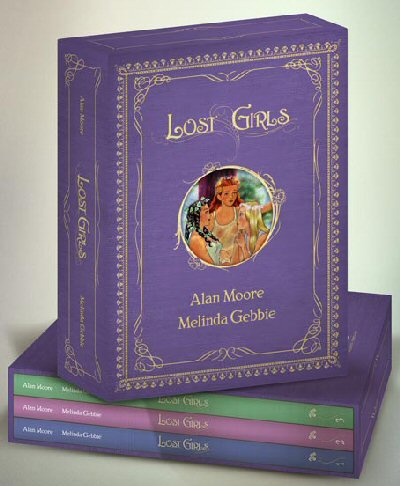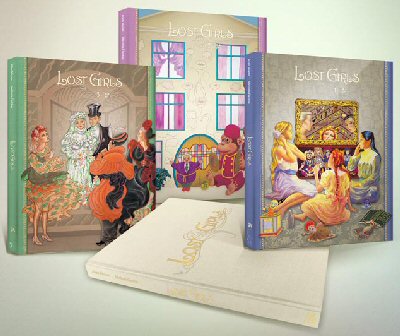
Well, it looks like Lost Girls is finally going to be a published reality. As you could imagine, if you know me IRL, or if you’ve been reading this blog for any length of time, I’m kind of a big ole’ drooling Alan Moore fanboy, so a new 240 pages graphic novel from him is a cause for some celebtration–especially when the format of the release is as swank as this one.
Top Shelf has an entry for it in their catalogue this time, with pictures and everything. (Nota bene: some of those pictures are probably NSFW.) The first part of this story appeared in Taboo in 1991, so that means this is a story that has been 15 years in the making. That’s mental.
The “high concept” pitch of the story is essentially that it’s Dorothy/Wendy/Alice slash. Yes, that’s Dorothy from the Wizard of Oz, Wendy from Peter Pan, and Alice from Alice In Wonderland. And it’s porn–make no mistake about that.

Here’s Moore’s slightly less high concept explanation:
I think it struck me that it was kind of unusual that there are all these relatively rarified areas of human experience that very few of us are actually involved in, such as being private detectives, space explorers, or vampire hunters. There are whole shelves full of books that are devoted to all of those exploits in every major city. However, we all have a sexuality, even if we’re celibate – that’s sexuality. And yet, the only medium – the only genre – that deals with sexuality is this grubby, under-the-counter genre in which there are absolutely no standards. It struck me that even though there have been many artists who’ve dabbled in the erotic and the pornographic in the past, most of them have done so anonymously, even if the work they’ve produced has been absolutely wonderful. They have not wished to associate that work with themselves, which means that there’s a whole area of art that is more or less completely ignored. And I wouldn’t have thought that we’d have that much culture that we could completely ignore this huge treasure trove of art and literature. It just seemed a bit strange to me that we seem to be laboring under this very odd idea that there is something wrong with looking at depictions of people having sex, and there must be something wrong, because you might get aroused.
…
And so, it was for all of these reasons that I thought, ‘Why not do a piece of pornography that is every bit as valid and as beautiful as you would expect from any work of art?’
That’s from an interview on the subject of Lost Girls at Cinescape.
Can he pull that off? Well, if anyone can, it’s probably Moore. Of course I haven’t seen the books yet, and probably won’t until June (and that’s assuming they make it across the border without Customs deciding they’re too pr0n-y to be allowed in), but people who have seen advance copies seem to think he pulls it off.
It is a work of art, as beautiful in its execution as it is defiant in its subject matter. Place it next to the KAMA SUTRA or De Sade’s PHILOSOPHY IN THE BEDROOM on your shelf.
That’s the conclusion Kurt Amacker–the Cinescape interviewer–reached after having read the book.
In an eight-page romp with Alice and Wendy, can he pay tribute to each of the seven deadly sins? Can he advance the narrative through shadows on a wall? Can he explore the idea that pornographers depict “the enchanted parklands where the most secret and vulnerable of all our many selves can safely play?”
Of course he can. He’s Alan Moore.
That’s Steve Duin in his piece on Lost Girls in The Oregonian.
This comic has driven me to complex thought, to patterns and ideas staying fixed in my own mental space that will stay with me. I will quote this book in conversation, I know it. I will see others through it, I will filter experience through it, it has affected me as much as any fiction can.
That’s Rich Johnston from his comments on the book in his Lying In The Gutters column.
So, in summary, it’s Alan Moore, it’s a gorgeously produced collection of books, it’s pornography but intelligent and with something to say, and the people who’ve read it think it succeeds. So why the question marks in the title of this post?
Well, two reasons.
First, I haven’t read the thing, so I can hardly recommend it, can I?
Second, there was something in Johnston’s piece that put me off a bit.
But the artistic potential of pornography is not just a virtue of “Lost Girls,” it’s part of the plot and structure. The hotelier claims to have solicited pornographic works from the greatest artists and writers of the day for a volume placed in each room of the hotel. As readers we are treated to glimpses of these works, often as parallels to the action and storyline. The nature of creating and enjoying fictional pornography, where no one is harmed, no matter what subject it touches on is both part of the narrative and part of the book’s theme. In a pornographic comic, or the illustrated prose featured of its time, and as not in a photographic magazine or film, there are only words and pictures created from nothing, no actual action, no one being used and abused save the reader. So then, what impact does that have on the repeated displays of paedophilia, incest, bestiality and non-consensual (at first) sex displayed in this book? Is it another exercise on Moore’s part to climb self referentially up his own arse? Is it an attempt to excuse the book’s content? Is it a comment on what pornography has become thanks to the grip of film making and photography? As unusual with Moore, it could be all these things. Like I said, I’m still thinking about it.
Children having sex with children and adults is the most viscerally disturbing. Again, the theme of taking classic children’s stories and either revealing or subverting their subtexts to that of blossoming sexuality and the exploration of such is itself commentary on the realities of fiction, but also the complexity of humanity which is very hard to label and box as modern society would like. As a society gets more and more obsessed on certain lines over what is not acceptable for children to see, read or experience, yet allows other equally potential dangers freely. The book fights against ingrained moralities, and is an uncomfortable read for that, yet it is hard not to celebrate in the freedoms it portrays, however unappealing.
Now in theory, I’m in support of all that–the idea of freedom to depict when no one is hurt, the idea of challenging social mores, etc. All fine–I do like to think of myself as an iconoclast.
However, “Children having sex with children and adults” still sets off all my new alarm bells. Ever since becoming a parent I’ve become absolutely draconian in my perceptions of the appropriate response to child abuse & molestation. All nuance and all shades of gray seem to have disappeared, leaving my with the kind of startlingly confident moral clarity that used to terrify me in others, and which still terrifies me in others with regard to any other subject. I mean, I’m starting to make Burke look like a bleeding heart. I suspect that any exploration of social mores around this will run smack into my new hot buttons.
I did find this quote in the second part of the Cinescape Moore interview:
AM: It was intentional in that we thought that if any form of art should build towards a climax, then it should be pornography. So, we decided that the first book – I don’t think there’s any penetration in it. The second book is a bit more unrestrained. In the third book, we are completely unrestrained, and we throw ourselves right into the orgiastic, full-on heart of pornography. I didn’t want anyone to accuse us of having cheated, of having done something like, ‘Well, you said it was pornography, but it wasn’t really, was it?’ So, we decided to confront the issue of sex with minors and incest. Those are in the White Book. It’s the pastiche of the Marquis von Bayros with a pastiche of a story by Pierre Louÿs. Both of these are fine and acclaimed artists. If anything, I think that we have probably done tamer art than Bayrough did, and tamer writing than Pierre Louÿs did. Not that both of them weren’t conspicuous works of art, but they are certainly much stronger than what we have done. What we wanted to do was make the point – as we have one of the characters make the point for us during one of the scenes – that these are not children. These are drawings of children.
KA: They are depictions.
AM: They are depictions. Yes, I can’t produce the birth certificates of these young-looking people to prove that they are, in fact, midgets at the age of 18, or whatever. You’re showing images of fictional children having consensual sex. This could be seen as wrong, whereas I, for the past couple of years, have been turning on my television and seeing pictures of actual, non-fictional children with their arms blown off. But, this is okay, because this is collateral damage. And, after all, they have only blown the arms off the children, killed all of their relatives, and left them with no un-blackened skin below the waist. It’s not like they’ve touched them sexually or anything. Frankly, when you’re confronted with that kind of vision on the six o’clock news, it makes all of these arguments about what it is permissible to depict in fiction completely laughable – almost an insult to our mutual humanity. If we can get so upset about lines on paper, but cannot somehow get upset about real flesh, real blood, real viscera, then what are we? So yes, I suppose that you could see those sections as deliberately provocative. I felt that I wanted to make a point there.
But of course, any coercive sex – whether it’s between adults, children, animals – any coercive act is wrong. That goes without saying.
So that makes me a little less worried, but I’m still kind of ambivalent about the whole thing. I’m not worried that what Moore has done is morally wrong or anything–I’m rock solid on the distinction between thoughts and actions, and I put writing and drawing into the “thoughts” category. I am worried, though, about what my reaction will be to his deliberate provocation, and whether or not that reaction will affect my ability to fully appreciate the work.
And since I am just enough of a Moore fanboy to lay out $150US for the signed/numbered version, I really want to fully appreciate the work.


1 comment for “Recommended Reading (??): Lost Girls”